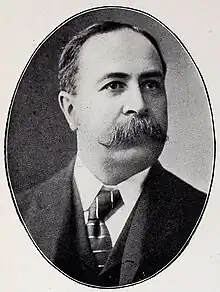Henry Hubbard Kendall | |
|---|---|
 | |
| Born | March 4, 1855 |
| Died | February 28, 1943 (aged 87) |
| Education | Massachusetts Institute of Technology (1875) |
| Occupation | Architect |
| 18th President of the American Institute of Architects | |
| In office 1920–1922 | |
| Preceded by | Thomas Rogers Kimball |
| Succeeded by | William Baker Faville |
Henry Hubbard Kendall (March 4, 1855 – February 28, 1943) was an American architect from Boston, Massachusetts.[1] He wrote a letter to the U.S. Civil Service commission critiquing the low pay for government architects.[2] Kendall was the senior partner in the firm Kendall, Taylor & Company. Several of his or the firm's works are listed on the U.S. National Register of Historic Places, for their architectural merit.
Kendall & Taylor was an architecture firm formed in 1908 by Henry H. Kendall and Bertrand E. Taylor. The firm did work in Durham, North Carolina.
Biography
Kendall was born March 4, 1855, in New Braintree, Massachusetts.[3] He graduated with a degree in architecture from the Massachusetts Institute of Technology at the age of 20.[3]
He was the senior partner at Kendall & Stevens in Boston with Edward F. Stevens (1890–95); and then Kendall, Taylor, and Stevens (1895–1909) with Stevens and Bertrand E. Taylor. He also formed Kendall, Stevens, and Lee (1909–12) (with Frederick Clare Lee).[4]
He was a fellow of the American Institute of Architects (AIA) and served as the group's president from 1920 to 1922.[5]
He died February 28, 1943, at his home in Newton Centre, Massachusetts.[3][6]
Works
Works (with attribution) include:
- Belchertown State School, 30 State St., Belchertown, Massachusetts (Kendall, Taylor & Co.), NRHP-listed
- Westborough State Hospital, along Lyman St. N of Chauncy Lake and jct. of South St. and MA 9, Westborough, Massachusetts (Kendall, Taylor & Stevens), NRHP-listed
- White Memorial Building, 109 Main St., Houlton, Maine (Kendall, Taylor & Stevens), NRHP-listed[7]
- Wrentham State School, Jct. of Emerald and North Sts., Wrentham, Massachusetts (Kendall & Taylor), NRHP-listed
- Contributing property Beech Hill Summer Home District, Harrisville, New Hampshire (Kendall, Taylor & Stevens), NRHP-listed
- John Sprunt Hill House, 900 S. Duke St., Durham, North Carolina (Kendall & Taylor), NRHP-listed
- Watts Hospital, Broad St. and Club Blvd., Durham, North Carolina (Kendall & Taylor), NRHP-listed
- A contributing property in the Watts-Hillandale Historic District, Durham, North Carolina (Kendall and Taylor), NRHP-listed
- One or more works in Beech Hill Summer Home District, Harrisville, New Hampshire (Kendall, Taylor & Stevens), NRHP-listed
- Massachusetts Mental Health Center, 74 Fenwood Rd., Boston, Massachusetts (Kendall, Taylor & Co.), NRHP-listed
- Watts Hospital, Broad St. and Club Blvd., Durham, North Carolina (Kendall & Taylor), NRHP-listed
- One or more works in Watts-Hillandale Historic District, Durham, North Carolina (Kendall and Taylor), NRHP-listed
References
- ↑ "The American Institute of Architects - AIA Presidents". aia.org. Retrieved 2014-01-25.
- ↑ College, A.J.L.T.M.A.P.H.P.G. (2000). Architects to the Nation : The Rise and Decline of the Supervising Architect's Office: The Rise and Decline of the Supervising Architect's Office. Oxford University Press, USA. ISBN 9780195351866.
- 1 2 3 Vosbeck, R. Randall; Wrenn, Tony P.; Smith, Andrew Brodie (2008). A Legacy of Leadership: The Presidents of the American Institute of Architects 1857–2007 (PDF). Washington, D.C.: The American Institute of Architects. pp. 54–55. ISBN 978-1-57165-021-4.
- ↑ bios McGill digital library
- ↑ "Kendall and Taylor".
- ↑ Henry H. Kendall Archived 2013-11-14 at archive.today AIA
- ↑ NRHP database
Further reading
- Entry Biographical Dictionary of American Architects Los Angeles by Henry F. Withey and Elsie Rathburn Withey, New Age Publishing Company, 1956. Facsimile edition, Hennessey & Ingalls, Inc., 1970
- Entry in FAIA, A Legacy of Leadership: Presidents of the AIA, 1857–2007 by R. Randall Vosbeck, Washington, DC: The American Institute of Architects, 2008